Esraa Shawgi, Noureldien A. Noureldien
Department of Information Systems, University of Science and Technology, Omdurman, Sudan
Correspondence to: Noureldien A. Noureldien, Department of Information Systems, University of Science and Technology, Omdurman, Sudan.
| Email: |  |
Copyright © 2015 Scientific & Academic Publishing. All Rights Reserved.
Abstract
Usability is commonly recognized as one of the most important quality factors of information systems. Different usability models for traditional information systems have been proposed. The current movement towards web-based information systems (WBIS) necessitates the need for special usability models for these systems. Accordingly questions such as how to measure the usability of WBIS and what to be considered during the development of websites to attain a high usability are raised. As a result, modeling usability of WBIS becomes an active researches filed and a new usability models for WBIS have been proposed. The goal of this paper is to develop a conceptual robust model that measure usability of WBIS. To achieve this goal we use an analytical methodology to analyze existing usability models to investigate their interrelationships, strength, and weaknesses. As a result, our developed model, the Usability Measurement Model (UMM), is built on the advantages and strength of usability models; ISO-9126-1 software quality standard, McCall model, website QEM model and 2QCV3Q model. We define the high-level usability factors in the new usability model as; accessibility, understandability, learnability, operability, attractiveness, and navigability, which are all defined in previous models, but not in one model. The new model defines a set of new sub factors; findability, clear labeling links, languages support, guidelines, help documents, descriptive comments, page load time, clear fonts, consistency, relevant graphics, good alignment of page elements, menu bar, link to home, use of frames, and search engine. To test the applicability and output of the UMM, we use the model in measuring usability of websites of three Sudanese universities. The attained results show that UMM is a promising, highly efficient usability model.
Keywords:
Information System Quality, Web-Based Information Systems Quality, Usability, Usability Metrics
Cite this paper: Esraa Shawgi, Noureldien A. Noureldien, Usability Measurement Model (UMM): A New Model for Measuring Websites Usability, International Journal of Information Science, Vol. 5 No. 1, 2015, pp. 5-13. doi: 10.5923/j.ijis.20150501.02.
1. Introduction
Usability is usually considered as the ability of the user to use a thing to perform a task successfully, where user experience takes a broader view, perceptions that result from that interaction.The International Standards Organization document [1] identifies three aspects of usability and defining it as ‘‘the extent to which a product can be used by specified users to achieve specified goals with effectiveness, efficiency, and satisfaction in a specified context of use.’’Usability evaluation is concerned with planning and conducting the measuring of the usability attributes of the user interface and identifying specific problems [2].There are many usability models that have been proposed to measure usability of traditional information systems, such as [3], which highlights the following usability attributes: learnability, efficiency, memorability, error rate, and satisfaction. However, the literature provides several other models, techniques and metrics that can be used for measuring usability.The web provides a new environment for information systems. This new environment defines new quality criteria, and therefore necessitates the need for new quality usability models. Some usability models that have been dedicated to WBIS have been proposed, such as 2QCV3Q model, and website QEM model.Although WBIS are defined to be websites that provides some application service to users, in this paper we will use the terms WBIS and website interchangeably.In this paper, we propose a new model for measuring WBIS usability. The developed model defines a new sub-factors behind those extracted from other models. The developed usability model defines the factors; accessibility, understandability, learn ability, operability, attractiveness, and navigability.The rest of this paper is organized as follows; Section 2 presents the related work. Section 3 discusses the quality models corporate to the developed model; in Section 4 a list of the common usability factors is given. Section 5 presents the new developed model, and in Section 6 we test the applicability of the developed model. Conclusions are given in Section 7.
2. Related Work
There were several previous works related to usability in websites or WBIS. One of the software evaluation models from the early 70’s, is McCall’s model (also known as McCall’s triangle of quality). It provides three different perspectives of software quality or property according to the major three processes in software life cycle: product operation (basic functionalities), product revision (ability to change), product transition (ability to adopt new environment) [4]. The usability factors of the McCall’s model are: operability, training and communicativeness.The ISO/IEC 9126 standard defines five usability factors; Understandability, learn ability, operability, attractive and usability compliance [5]. In [6], a conceptual model that consists of 7 dimensions to evaluate the quality of a website was proposed. The model defines accessibility, navigability and understandability as usability factors.A framework for approaching the exponentially-growing number of studies devoted to e-learning in general and the design of usable e-learning specifically, is described in [7]. A study that evaluates usability of a university website was proposed in [8]. The study defines two criteria for usability: survey ability (user perception of satisfactory layout) and findability observed ease of use.A usability evaluation study on academic websites of Jordanian university listed out quality factors in 5 main categories: content, organization and readability, navigation and links, user interface design, performance and effectiveness and, educational information [9]. It outlined quality factors such as content, authority, organization and accessibility.A similar study conducted to evaluate the usability of Lund University’s research and home page outlined quality factors in two categories: user experiences and website success. Under user experience they define quality factors such as: usability, functionality, content and branding. The usability factors of this study are: efficiency, learnability, error rates, and satisfaction [10].Usability and Search Engine Optimization (SEO) are important issues studied by many researchers. In [1], three internal usability attributes are selected: HTML errors checking, load time, and browser compatibility problems. Three tools (HTML Toolbox, Page Rank Checker, and SEO Page Rank) were used to conduct the evaluation.A recent study [11], defines a wide set of academic quality attributes and grouping them into a requirement tree, called web-site QEM. The quality factors in web-site QEM are: Aesthetics, ease of use, multimedia, rich content and reputation. They give the usability the factors: consistency, navigation, and comment.Table (1) summering usability factors in previous studies. understood, learned, used and attractive to the user, when used under specified conditions [5].Table 1. Usability Factors in Previous Websites Evaluation Models
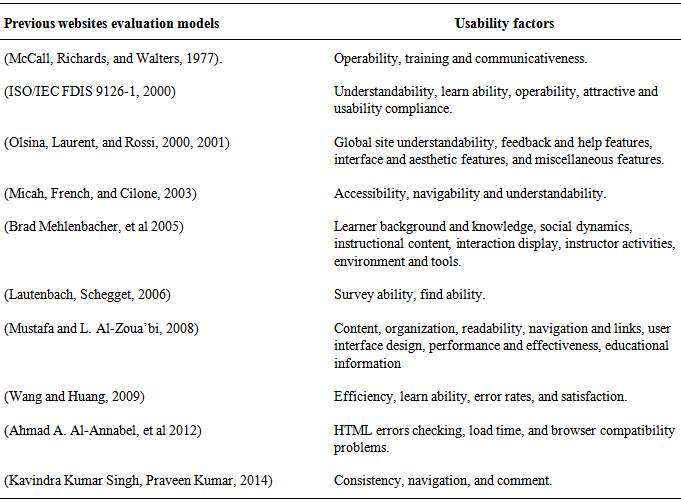 |
| |
|
The usability subfactors in this standard are learnability, understandability, operability, attractiveness, and usability.
3. Models Contribute to the Developed Model
In this section, the usability models that are contributed to the developed model are briefly reviewed.
3.1. Usability in ISO 9126 Quality Standard Model
The ISO/IEC 9126-1 represents the Software Engineering (SE) perspective on usability. In SE, usability is defined as being the capability of the software product to be usability compliance, as shown in figure (1). | Figure 1. ISO 9126-1 Usability Standard |
3.2. Usability in McCall’s Model
McCall’s model (also known as McCall’s triangle of quality) is one of the software evaluation models from the early 70’s. It provides three different perspectives of software quality or property according to the major three processes in software life cycle: product operation (basic functionalities), product revision (ability to change), product transition (ability to adopt new environment) [4].The usability characteristic in this model, shown in figure (2), is under product operation processes that contain sub-factors such as operability, training, and communicativeness.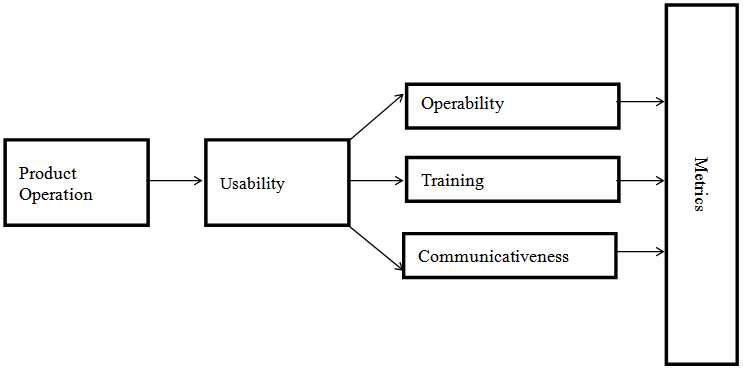 | Figure 2. McCall’s Software Usability Model |
3.3. Usability in 2QCV3Q-model
This is a conceptual model consisting of 7 dimensions to evaluate quality of a website: who-what-why- when-where-how and feasibility (with what means and devices) [6]. The quality factors and attributes of this model are shown in figure (3) below.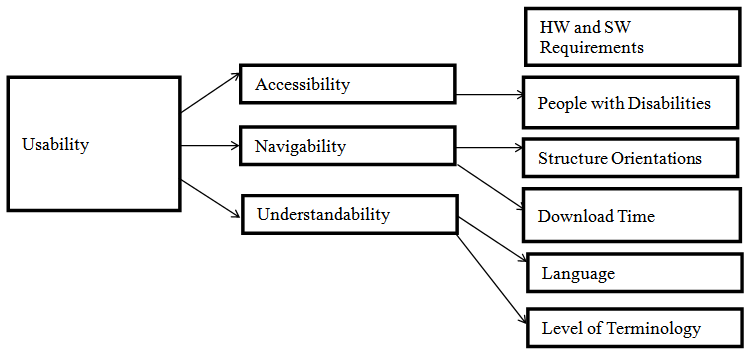 | Figure 3. The 2QCV3Q Usability Model |
Usability is the most thoroughly studied dimension, it determines how efficiently and effectively the site’s content and services are made available to the user. To do this, the target of the site must be considered as a variable factor; the user’s familiarity with computers and web navigation, the hardware and software used, the modality used to access the site, as well as the user’s language skills must all be taken into account.
3.4. Web Quality Evaluation Model (QEM)
QEM is a website evaluation framework; it has three-level structure, quality factors, quality sub-level factors and measurable criteria (indicators). At the first level, the framework proposes five quality factors that include aesthetics, ease of use, multimedia, rich content and reputation. The second level of characteristic is broken down by several sub-factors. Each sub-characteristic is inherited from parental quality factors [11].The ease of use has consistency, navigation and comment as subfactors, as shown in figure (4). | Figure 4. Major Usability Factors and sub Factors of Web-site QEM Model |
The common factors of usability in the above usability models are shown in table (2).Table 2. The Common Attributes of Usability Factor
 |
| |
|
4. A New Model for Web Sites Usability Measurement
To design the new usability measurement model, a careful study was made on key usability factors for websites, previous related works in websites evaluation models and the usability factors in the proposed website usability models, in order to identify necessary high-level usability factors, sub factors and criteria. The new model first outlines high usability factors, which are further divided into sub factors and criteria. The common usability factors in related models; the ISO-9126-1 software quality standard, McCall model, Web-site QEM model, and 2QCV3Q model are considered as high usability factors in the new model, but new sub factors have been defined.We define the high-level usability factors in the new usability model as; accessibility, understandability, learn ability, operability, attractiveness, and navigability, which are all defined in previous models, but not in one model.The new model defines a set of new sub factors; find ability, clear labeling links, languages support, guidelines, help documents, descriptive comments, page load time, clear fonts, consistency, relevant graphics, good alignment of page elements, menu bar, link to home, use of frames, search engine as shown in figure (5).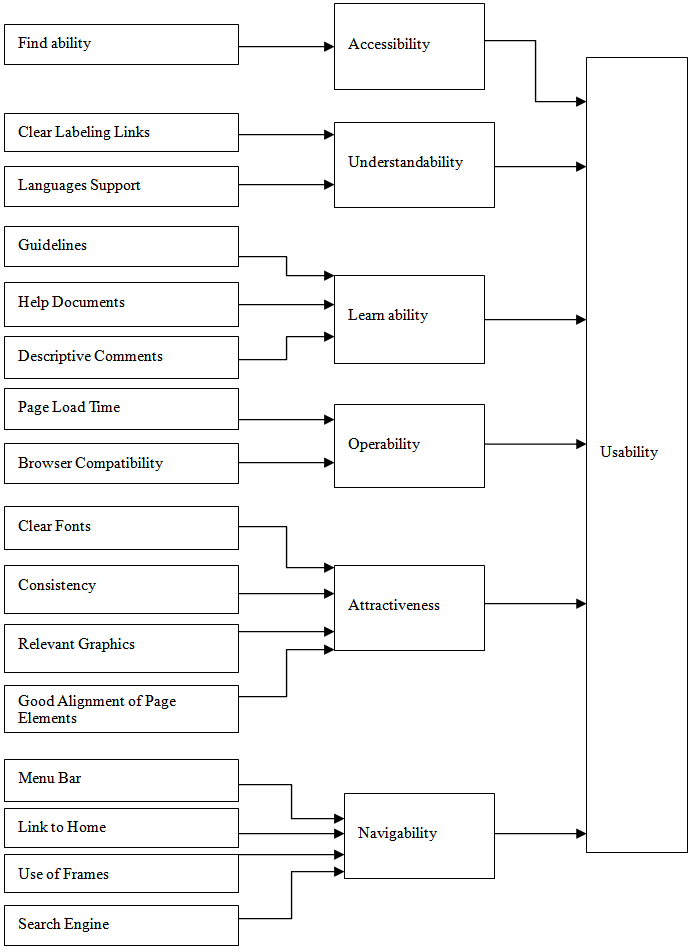 | Figure 5. Usability Measurement Model (UMM) |
Our conjecture to eliminate the high-level usability factors; compliance, training and communicativeness that have been defined in previous models in table (2) is as follow:■ The compliance means that, the software developers adhere to application related standards or conventions or regulations in laws and similar prescriptions. There are some countries that have stated regulations for websites design while others are not, so it cannot be a general factor. ■ The training is close to the concept of learn ability; learn ability means that the website should not be cumbersome for users to learn how to use it. Necessary help documents and other supplemental materials can describe how to use the website, while training means that the usability may include human factors such as training materials (e.g. tutorials). Therefore the two concepts shared the same meaning. Thus learn ability canceled the need for using training as a usability factor. ■ The communicativeness means that it is possible to easily specify and understand inputs and outputs from the system, which facilitates the construction of test cases [12]; therefore it is a testability factor rather than a usability factor.■ The sub factors used in UMM model from previous models are shown in table (3) below:Table 3. Usability Sub Factors in the Developed Model
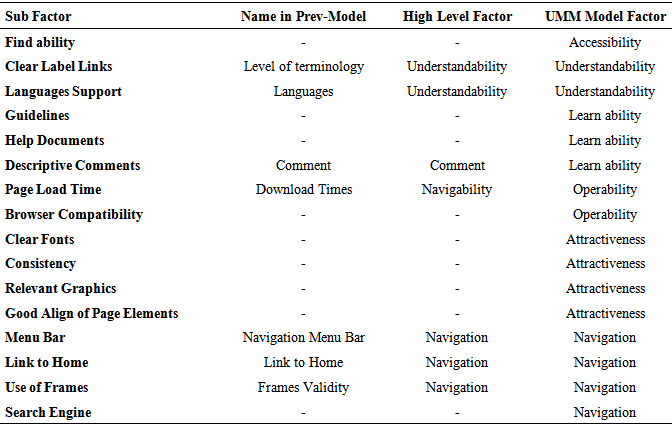 |
| |
|
■ (-) means new sub factor.Table (4) shows that UMM combines all conceptual dimensions used in previous models to buildup usability factors. | Table 4. Comparison between the New Model and Previous Models |
5. Testing Applicability of the Usability Measurement Model
Usability Measurement Model can be used to measure usability of websites using a 0% to 100% scale, where 0% indicates poor quality of usability and 100% shows the excellent quality of usability. Measuring usability using UMM is a bottom up approach. The score of the high level factors of UMM is calculated using scores earned by the lower level sub factors. The accumulated scores of high level factors define the total usability score. Where SFw denotes the score earned by the sub factor, and k denotes the number of sub factors of a higher factor.To test the applicability of the UMM, a practical evaluation of websites is carried out. The results show the veracity of the model.We use UMM to measure the usability of University of Khartoum website. http://www.uofk.edu. To assign weights to sub factors we assume that all sub factors have the same weight, and since the total score is 100 and the number of sub factors is 16, the weight for each sub factor is 6.25. The weight earned by some sub factors is assigned based on attribute existence, so either 0 or 6.25 is assigned. Some other sub factors are weighted using tools, we use the Sort-Site testing tool to measure search engine and browser compatibility, it is a one-click website testing tool used by federal agencies, fortune100corporationsandindependent consultants, www.powermapper.com/products/sortsite/, the tool is available as a subscription web application and a Windows desktop application. Also we use the Kingdom website speed test tool, www.tools.pingdom.com, to measure page load time; all tests are done with real web browsers. Figures (6) and (7) show the usability sub factors of the home page of University of Khartoum had been assigned based on attribute existence.
Where SFw denotes the score earned by the sub factor, and k denotes the number of sub factors of a higher factor.To test the applicability of the UMM, a practical evaluation of websites is carried out. The results show the veracity of the model.We use UMM to measure the usability of University of Khartoum website. http://www.uofk.edu. To assign weights to sub factors we assume that all sub factors have the same weight, and since the total score is 100 and the number of sub factors is 16, the weight for each sub factor is 6.25. The weight earned by some sub factors is assigned based on attribute existence, so either 0 or 6.25 is assigned. Some other sub factors are weighted using tools, we use the Sort-Site testing tool to measure search engine and browser compatibility, it is a one-click website testing tool used by federal agencies, fortune100corporationsandindependent consultants, www.powermapper.com/products/sortsite/, the tool is available as a subscription web application and a Windows desktop application. Also we use the Kingdom website speed test tool, www.tools.pingdom.com, to measure page load time; all tests are done with real web browsers. Figures (6) and (7) show the usability sub factors of the home page of University of Khartoum had been assigned based on attribute existence.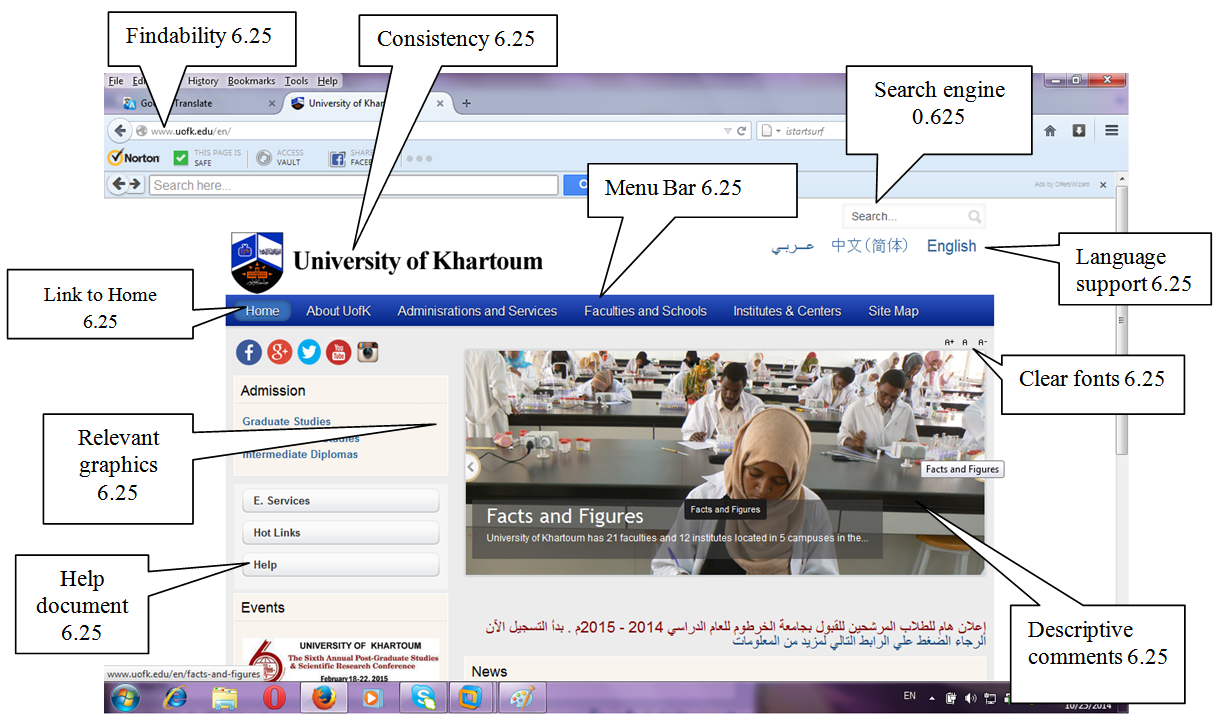 | Figure 6. Home Page University of Khartoum Part1 |
 | Figure 7. Home Page University of Khartoum Part |
The subfactors that are weighted using toolsare ssigned the following scores:- The browser compatibility takes 3.75 score, ((6.25 * 6) / 10)=3.75, since the Sort-Site testing tool finds errors in 4 pages out of 10 pages in compatibility attribute on the website.THe average of page load time in the world is (11.62 seconds = 100%) as measured by Google analytics (Google Analytics, 2014), the average of page load time score is 3.3, since it takes 6.25 score according to Pingdom website speed test tool.- The search engine takes 0.625 score ((1*6.25)/10) = 0.625, since the Sort-Site testing tool finds errors in 9 pages from 10 pages in search engine attribute on the website.Figure (8) shows the graphical representation of usability sub factors. | Figure 8. Graphical Representation of Usability Factors in of University of Khartoum Website |
Thus the Total Usability Score is = 6.25 + 12.5 + 18.75 +10 + 25 +19.375 = 91.9%.
6. Conclusions
In this paper we developed a new model for measuring the usability of web based information systems. The model defines 6 factors: understandability, learn ability, accessibility, operability, navigation, and attractiveness. These 6 factors conistitute16 sub factors: use of frames, link to home, menu bar, good alignment of page elements, relevant graphics, consistent colors, clear fonts, smoothness of contents, descriptive comments, help documents, guidelines, languages support, clear labeling links, browser compatibility, find ability, and search engine. The applicability of the model has been tested by using the model as a usability measurement to a university website.The model we have present is by no means a final conclusion on how usability of websites can be measured, but we have provided a model which can be used by practitioners and extended by researchers.
References
| [1] | ISO/IEC, 9241-11. (1998). Ergonomic requirements for office work with visual display terminals. (VDT) s -Part 11 Guidance on usability: ISO/IEC 9241-11. |
| [2] | Ivory, M., and Hearst, M. (2001). The state of the art in automating usability evaluation of user interfaces, ACM Computing Surveys 33: 470–516. |
| [3] | Nielsen, J. (1993). Usability Engineering. Academic Press, Boston, ISBN 0-12-518405-0. |
| [4] | McCall, J., Richards, P, Walters, G. (1977). Factors in Software Quality, Nat'l Tech. Information Service, no.Vol.1, 2 and 3. |
| [5] | ISO/IEC, FDIS 9126-1. (2000). Information technology-Software product quality - Part 1: Quality model. |
| [6] | Mich, L., French, M. and Cilone, G. (2003).the 2QCV3Q Quality model for the analysis of web site requirements. Journal of Web Engineering, vol. 2, pp. 105-127. |
| [7] | Brad, M., Leslie, B., Tammy, B., Melonie, I., Jan, L., Janet, M., Lisa, W. (2005). Usable E-Learning: A Conceptual Model for Evaluation and Design: NC State University. P, 1-10. |
| [8] | Lautenbach, M., Schegget, I., Schoute, A. and Witteman, C. (2006). "Evaluating the usability of web pages: a case study. Utrecht University. Utrecht. |
| [9] | Mustafa, S., Al-Zoua’bi, L. (2008). Usability of the Academic Websites of Jordan's Universities an Evaluation Study. Yarmouk University, Faculty of Information Technology. |
| [10] | Wang, X., Huang, W. (2009). Lund University Website Evaluation: Focus on homepage and English research pages. In Informatics. Vol. Masters Lund, Sweden: Lund University. |
| [11] | Kavindra, K., Praveen, K. (2014). A new Model for Website Quality Evaluation – A practical approach: International Journal of Research in Engineering & Technology. |
| [12] | Boehm, B, Brown, J,. Lipow, M. (1976). Quantitative Evaluation of Software Quality, Proc. of the 2nd Intl. Conf. on Software Engineering. pp. 592-60. |







 Where SFw denotes the score earned by the sub factor, and k denotes the number of sub factors of a higher factor.To test the applicability of the UMM, a practical evaluation of websites is carried out. The results show the veracity of the model.We use UMM to measure the usability of University of Khartoum website. http://www.uofk.edu. To assign weights to sub factors we assume that all sub factors have the same weight, and since the total score is 100 and the number of sub factors is 16, the weight for each sub factor is 6.25. The weight earned by some sub factors is assigned based on attribute existence, so either 0 or 6.25 is assigned. Some other sub factors are weighted using tools, we use the Sort-Site testing tool to measure search engine and browser compatibility, it is a one-click website testing tool used by federal agencies, fortune100corporationsandindependent consultants, www.powermapper.com/products/sortsite/, the tool is available as a subscription web application and a Windows desktop application. Also we use the Kingdom website speed test tool, www.tools.pingdom.com, to measure page load time; all tests are done with real web browsers. Figures (6) and (7) show the usability sub factors of the home page of University of Khartoum had been assigned based on attribute existence.
Where SFw denotes the score earned by the sub factor, and k denotes the number of sub factors of a higher factor.To test the applicability of the UMM, a practical evaluation of websites is carried out. The results show the veracity of the model.We use UMM to measure the usability of University of Khartoum website. http://www.uofk.edu. To assign weights to sub factors we assume that all sub factors have the same weight, and since the total score is 100 and the number of sub factors is 16, the weight for each sub factor is 6.25. The weight earned by some sub factors is assigned based on attribute existence, so either 0 or 6.25 is assigned. Some other sub factors are weighted using tools, we use the Sort-Site testing tool to measure search engine and browser compatibility, it is a one-click website testing tool used by federal agencies, fortune100corporationsandindependent consultants, www.powermapper.com/products/sortsite/, the tool is available as a subscription web application and a Windows desktop application. Also we use the Kingdom website speed test tool, www.tools.pingdom.com, to measure page load time; all tests are done with real web browsers. Figures (6) and (7) show the usability sub factors of the home page of University of Khartoum had been assigned based on attribute existence.


 Abstract
Abstract Reference
Reference Full-Text PDF
Full-Text PDF Full-text HTML
Full-text HTML

